BA30592E: Recording Business Transactions Assignment - October 2020
VerifiedAdded on 2022/12/29
|13
|2520
|97
Homework Assignment
AI Summary
This assignment solution presents a comprehensive analysis of a toy business's financial transactions for October 2020. It begins with the double-entry record of various transactions, including initial capital contributions, purchases, sales, expenses, and drawings. The solution then meticulously records these transactions in T-accounts for each relevant account, such as Bank, Cash, Capital, and Sales. A trial balance is prepared to ensure the equality of debits and credits. Furthermore, the assignment includes the preparation of a profit and loss statement, calculating the net profit for the month, and a balance sheet outlining the company's assets, liabilities, and equity at the end of October. The solution also analyzes the implications of drawings, differentiating between business and personal expenses. Finally, the assignment delves into ratio analysis, calculating and interpreting key financial ratios such as net profit margin, gross profit margin, current ratio, acid test ratio, accounts receivable collection period, and accounts payable payment period, comparing the business's performance to competitors and identifying areas for improvement.
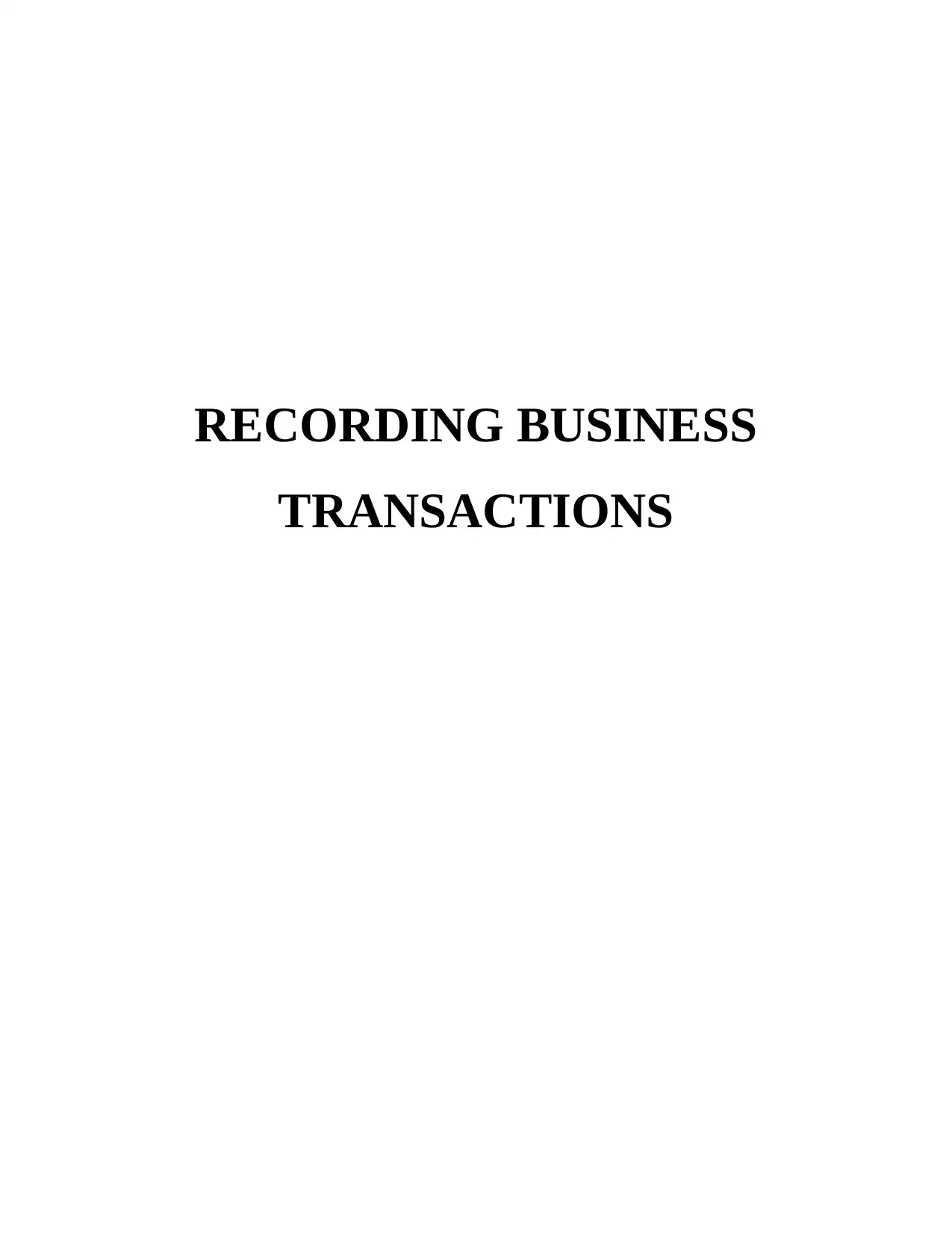
RECORDING BUSINESS
TRANSACTIONS
TRANSACTIONS
Paraphrase This Document
Need a fresh take? Get an instant paraphrase of this document with our AI Paraphraser
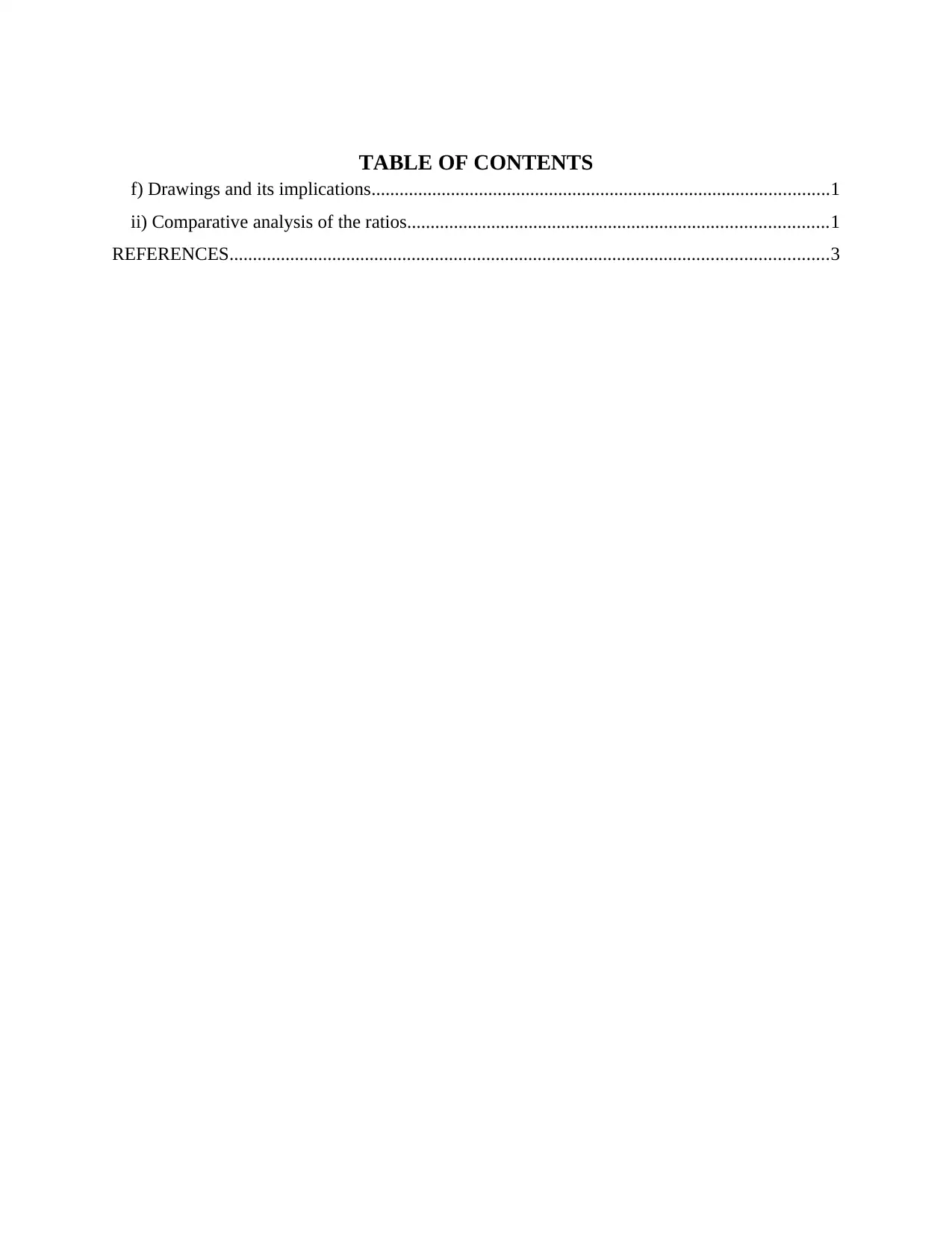
TABLE OF CONTENTS
f) Drawings and its implications..................................................................................................1
ii) Comparative analysis of the ratios..........................................................................................1
REFERENCES................................................................................................................................3
f) Drawings and its implications..................................................................................................1
ii) Comparative analysis of the ratios..........................................................................................1
REFERENCES................................................................................................................................3
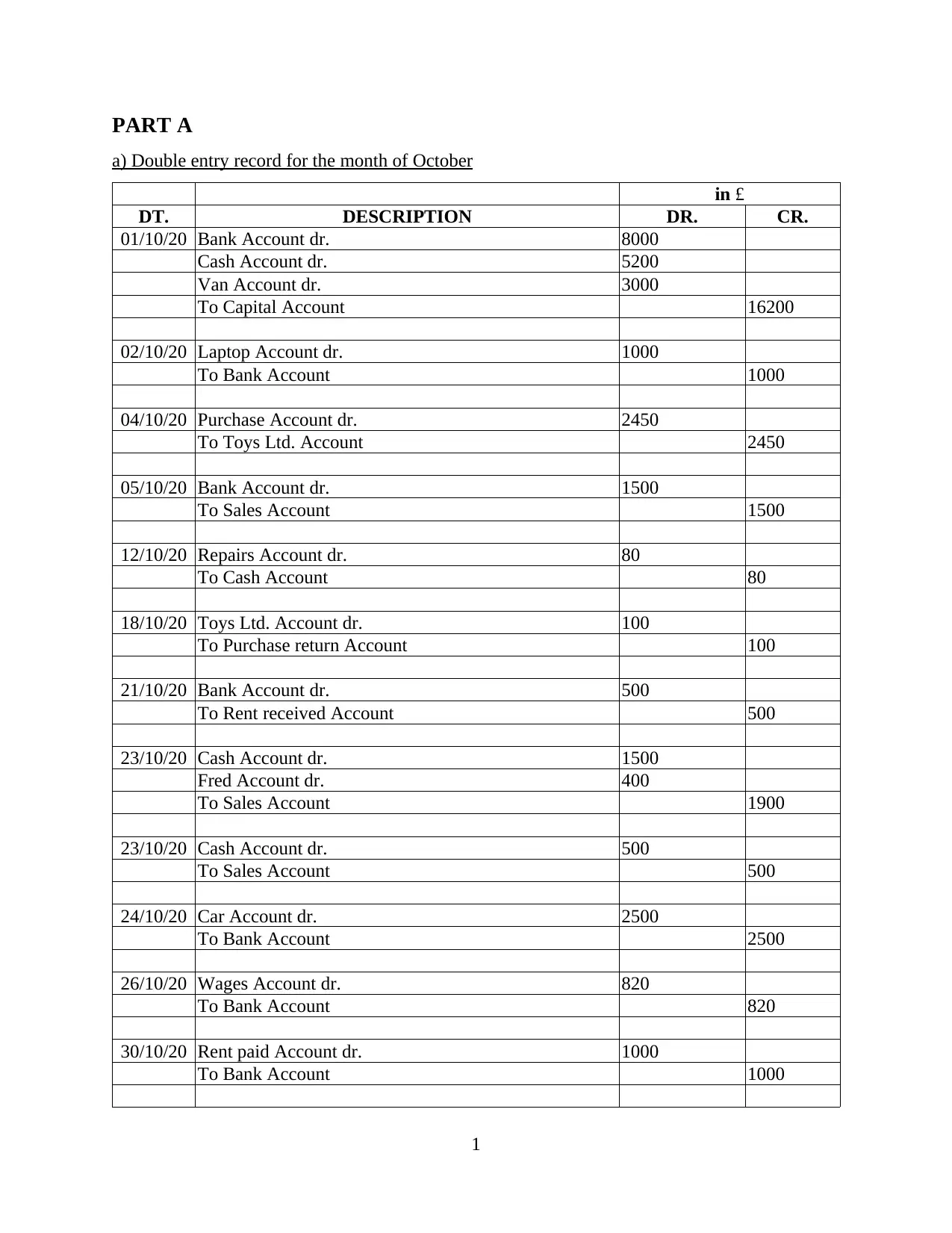
PART A
a) Double entry record for the month of October
in £
DT. DESCRIPTION DR. CR.
01/10/20 Bank Account dr. 8000
Cash Account dr. 5200
Van Account dr. 3000
To Capital Account 16200
02/10/20 Laptop Account dr. 1000
To Bank Account 1000
04/10/20 Purchase Account dr. 2450
To Toys Ltd. Account 2450
05/10/20 Bank Account dr. 1500
To Sales Account 1500
12/10/20 Repairs Account dr. 80
To Cash Account 80
18/10/20 Toys Ltd. Account dr. 100
To Purchase return Account 100
21/10/20 Bank Account dr. 500
To Rent received Account 500
23/10/20 Cash Account dr. 1500
Fred Account dr. 400
To Sales Account 1900
23/10/20 Cash Account dr. 500
To Sales Account 500
24/10/20 Car Account dr. 2500
To Bank Account 2500
26/10/20 Wages Account dr. 820
To Bank Account 820
30/10/20 Rent paid Account dr. 1000
To Bank Account 1000
1
a) Double entry record for the month of October
in £
DT. DESCRIPTION DR. CR.
01/10/20 Bank Account dr. 8000
Cash Account dr. 5200
Van Account dr. 3000
To Capital Account 16200
02/10/20 Laptop Account dr. 1000
To Bank Account 1000
04/10/20 Purchase Account dr. 2450
To Toys Ltd. Account 2450
05/10/20 Bank Account dr. 1500
To Sales Account 1500
12/10/20 Repairs Account dr. 80
To Cash Account 80
18/10/20 Toys Ltd. Account dr. 100
To Purchase return Account 100
21/10/20 Bank Account dr. 500
To Rent received Account 500
23/10/20 Cash Account dr. 1500
Fred Account dr. 400
To Sales Account 1900
23/10/20 Cash Account dr. 500
To Sales Account 500
24/10/20 Car Account dr. 2500
To Bank Account 2500
26/10/20 Wages Account dr. 820
To Bank Account 820
30/10/20 Rent paid Account dr. 1000
To Bank Account 1000
1
⊘ This is a preview!⊘
Do you want full access?
Subscribe today to unlock all pages.

Trusted by 1+ million students worldwide
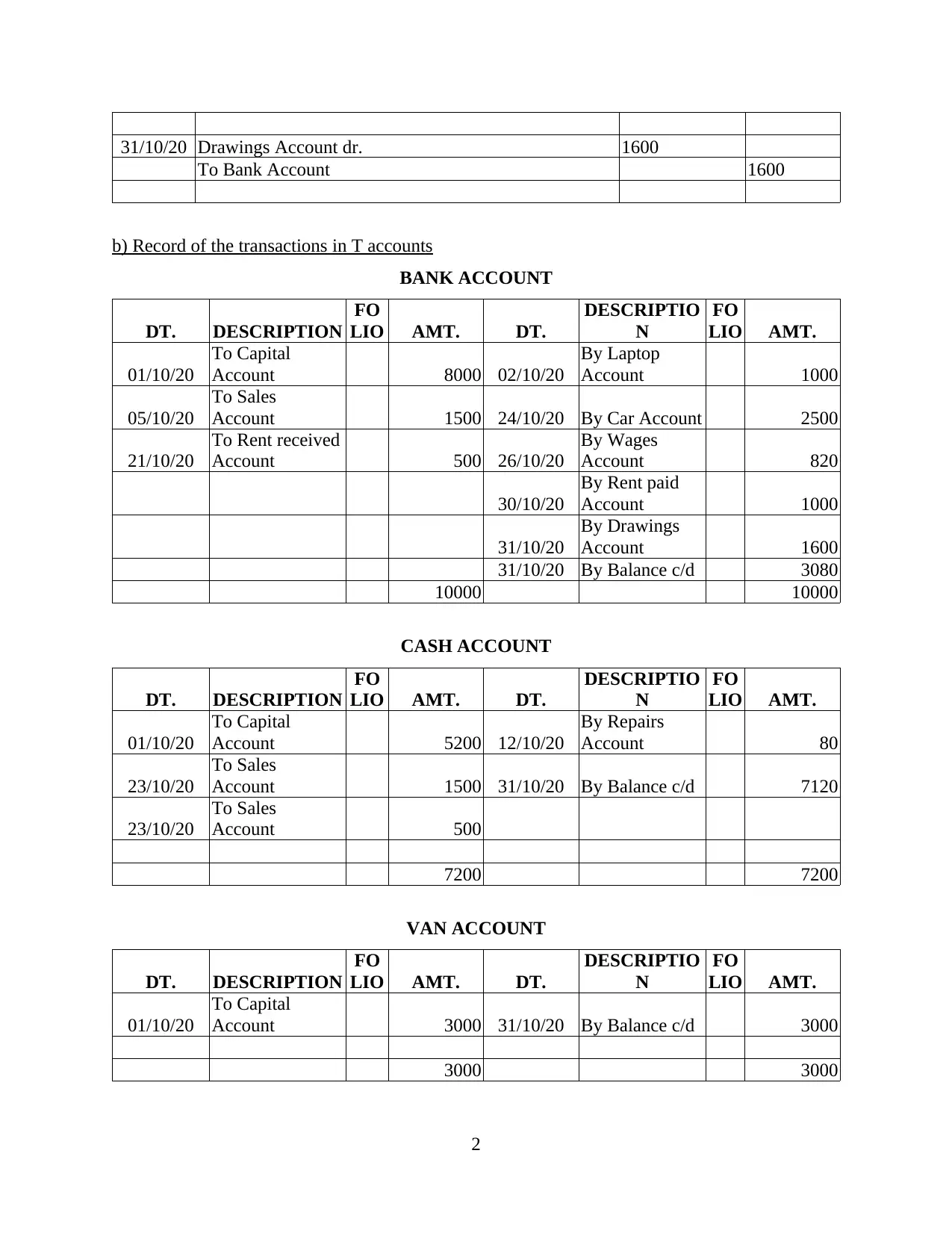
31/10/20 Drawings Account dr. 1600
To Bank Account 1600
b) Record of the transactions in T accounts
BANK ACCOUNT
DT. DESCRIPTION
FO
LIO AMT. DT.
DESCRIPTIO
N
FO
LIO AMT.
01/10/20
To Capital
Account 8000 02/10/20
By Laptop
Account 1000
05/10/20
To Sales
Account 1500 24/10/20 By Car Account 2500
21/10/20
To Rent received
Account 500 26/10/20
By Wages
Account 820
30/10/20
By Rent paid
Account 1000
31/10/20
By Drawings
Account 1600
31/10/20 By Balance c/d 3080
10000 10000
CASH ACCOUNT
DT. DESCRIPTION
FO
LIO AMT. DT.
DESCRIPTIO
N
FO
LIO AMT.
01/10/20
To Capital
Account 5200 12/10/20
By Repairs
Account 80
23/10/20
To Sales
Account 1500 31/10/20 By Balance c/d 7120
23/10/20
To Sales
Account 500
7200 7200
VAN ACCOUNT
DT. DESCRIPTION
FO
LIO AMT. DT.
DESCRIPTIO
N
FO
LIO AMT.
01/10/20
To Capital
Account 3000 31/10/20 By Balance c/d 3000
3000 3000
2
To Bank Account 1600
b) Record of the transactions in T accounts
BANK ACCOUNT
DT. DESCRIPTION
FO
LIO AMT. DT.
DESCRIPTIO
N
FO
LIO AMT.
01/10/20
To Capital
Account 8000 02/10/20
By Laptop
Account 1000
05/10/20
To Sales
Account 1500 24/10/20 By Car Account 2500
21/10/20
To Rent received
Account 500 26/10/20
By Wages
Account 820
30/10/20
By Rent paid
Account 1000
31/10/20
By Drawings
Account 1600
31/10/20 By Balance c/d 3080
10000 10000
CASH ACCOUNT
DT. DESCRIPTION
FO
LIO AMT. DT.
DESCRIPTIO
N
FO
LIO AMT.
01/10/20
To Capital
Account 5200 12/10/20
By Repairs
Account 80
23/10/20
To Sales
Account 1500 31/10/20 By Balance c/d 7120
23/10/20
To Sales
Account 500
7200 7200
VAN ACCOUNT
DT. DESCRIPTION
FO
LIO AMT. DT.
DESCRIPTIO
N
FO
LIO AMT.
01/10/20
To Capital
Account 3000 31/10/20 By Balance c/d 3000
3000 3000
2
Paraphrase This Document
Need a fresh take? Get an instant paraphrase of this document with our AI Paraphraser
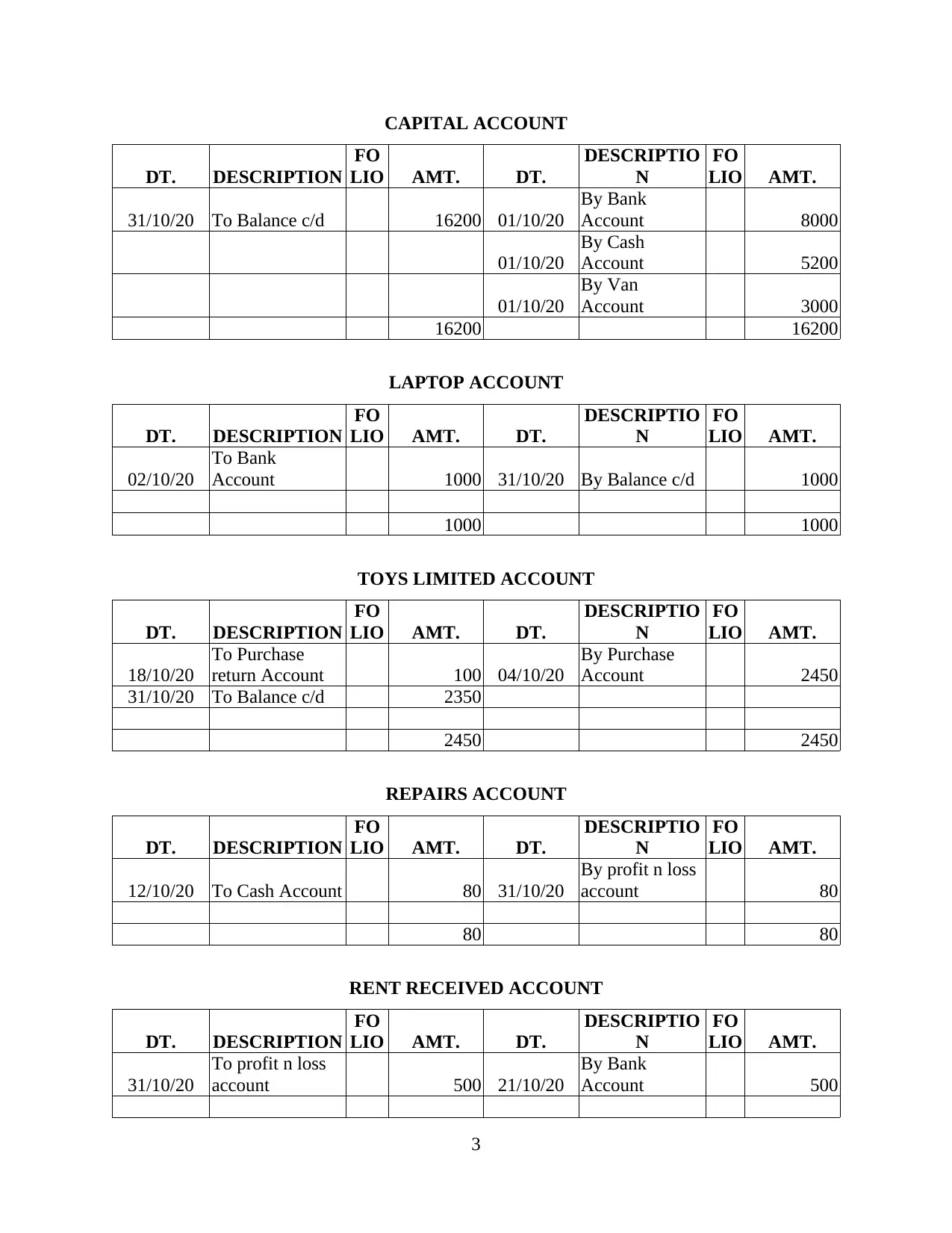
CAPITAL ACCOUNT
DT. DESCRIPTION
FO
LIO AMT. DT.
DESCRIPTIO
N
FO
LIO AMT.
31/10/20 To Balance c/d 16200 01/10/20
By Bank
Account 8000
01/10/20
By Cash
Account 5200
01/10/20
By Van
Account 3000
16200 16200
LAPTOP ACCOUNT
DT. DESCRIPTION
FO
LIO AMT. DT.
DESCRIPTIO
N
FO
LIO AMT.
02/10/20
To Bank
Account 1000 31/10/20 By Balance c/d 1000
1000 1000
TOYS LIMITED ACCOUNT
DT. DESCRIPTION
FO
LIO AMT. DT.
DESCRIPTIO
N
FO
LIO AMT.
18/10/20
To Purchase
return Account 100 04/10/20
By Purchase
Account 2450
31/10/20 To Balance c/d 2350
2450 2450
REPAIRS ACCOUNT
DT. DESCRIPTION
FO
LIO AMT. DT.
DESCRIPTIO
N
FO
LIO AMT.
12/10/20 To Cash Account 80 31/10/20
By profit n loss
account 80
80 80
RENT RECEIVED ACCOUNT
DT. DESCRIPTION
FO
LIO AMT. DT.
DESCRIPTIO
N
FO
LIO AMT.
31/10/20
To profit n loss
account 500 21/10/20
By Bank
Account 500
3
DT. DESCRIPTION
FO
LIO AMT. DT.
DESCRIPTIO
N
FO
LIO AMT.
31/10/20 To Balance c/d 16200 01/10/20
By Bank
Account 8000
01/10/20
By Cash
Account 5200
01/10/20
By Van
Account 3000
16200 16200
LAPTOP ACCOUNT
DT. DESCRIPTION
FO
LIO AMT. DT.
DESCRIPTIO
N
FO
LIO AMT.
02/10/20
To Bank
Account 1000 31/10/20 By Balance c/d 1000
1000 1000
TOYS LIMITED ACCOUNT
DT. DESCRIPTION
FO
LIO AMT. DT.
DESCRIPTIO
N
FO
LIO AMT.
18/10/20
To Purchase
return Account 100 04/10/20
By Purchase
Account 2450
31/10/20 To Balance c/d 2350
2450 2450
REPAIRS ACCOUNT
DT. DESCRIPTION
FO
LIO AMT. DT.
DESCRIPTIO
N
FO
LIO AMT.
12/10/20 To Cash Account 80 31/10/20
By profit n loss
account 80
80 80
RENT RECEIVED ACCOUNT
DT. DESCRIPTION
FO
LIO AMT. DT.
DESCRIPTIO
N
FO
LIO AMT.
31/10/20
To profit n loss
account 500 21/10/20
By Bank
Account 500
3
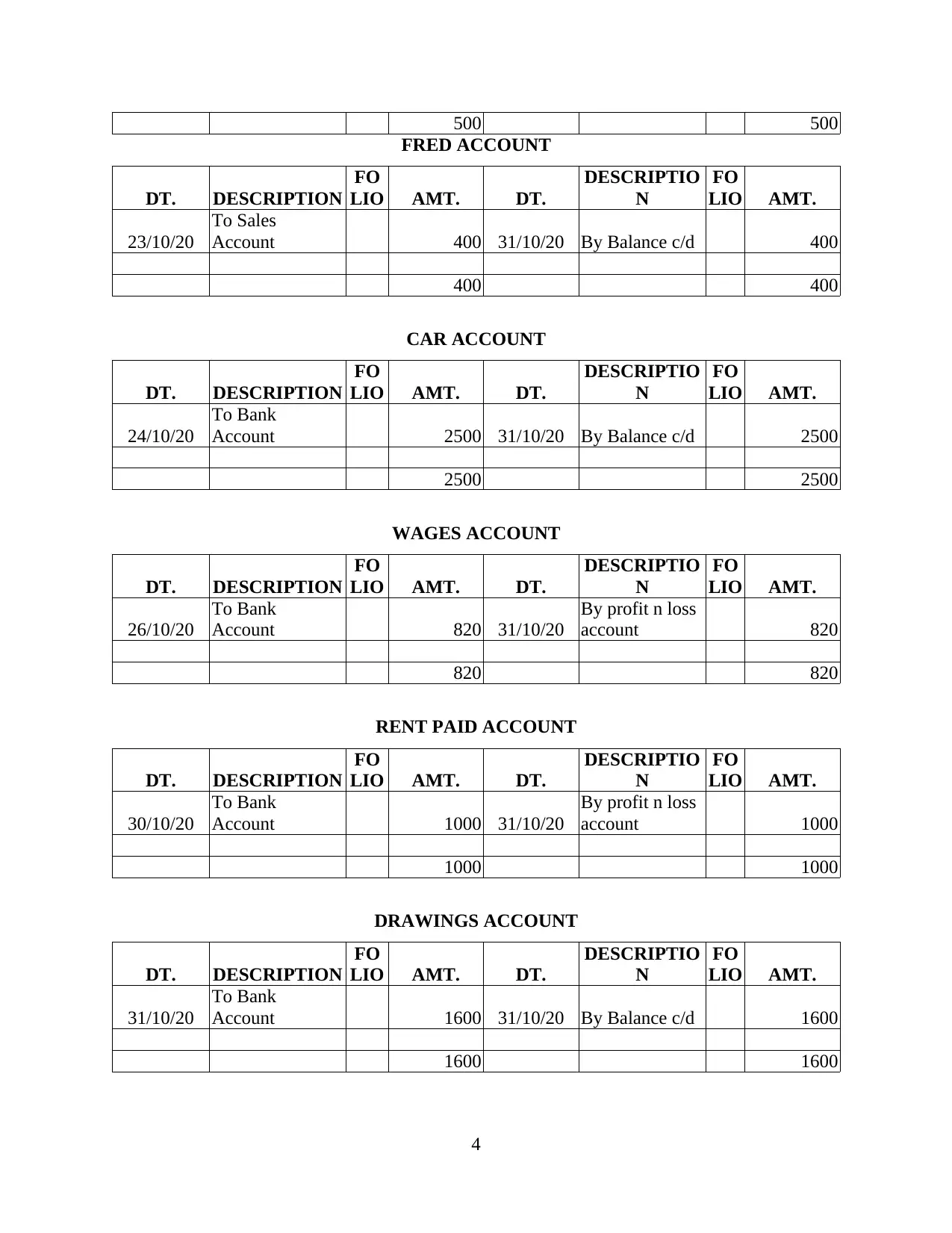
500 500
FRED ACCOUNT
DT. DESCRIPTION
FO
LIO AMT. DT.
DESCRIPTIO
N
FO
LIO AMT.
23/10/20
To Sales
Account 400 31/10/20 By Balance c/d 400
400 400
CAR ACCOUNT
DT. DESCRIPTION
FO
LIO AMT. DT.
DESCRIPTIO
N
FO
LIO AMT.
24/10/20
To Bank
Account 2500 31/10/20 By Balance c/d 2500
2500 2500
WAGES ACCOUNT
DT. DESCRIPTION
FO
LIO AMT. DT.
DESCRIPTIO
N
FO
LIO AMT.
26/10/20
To Bank
Account 820 31/10/20
By profit n loss
account 820
820 820
RENT PAID ACCOUNT
DT. DESCRIPTION
FO
LIO AMT. DT.
DESCRIPTIO
N
FO
LIO AMT.
30/10/20
To Bank
Account 1000 31/10/20
By profit n loss
account 1000
1000 1000
DRAWINGS ACCOUNT
DT. DESCRIPTION
FO
LIO AMT. DT.
DESCRIPTIO
N
FO
LIO AMT.
31/10/20
To Bank
Account 1600 31/10/20 By Balance c/d 1600
1600 1600
4
FRED ACCOUNT
DT. DESCRIPTION
FO
LIO AMT. DT.
DESCRIPTIO
N
FO
LIO AMT.
23/10/20
To Sales
Account 400 31/10/20 By Balance c/d 400
400 400
CAR ACCOUNT
DT. DESCRIPTION
FO
LIO AMT. DT.
DESCRIPTIO
N
FO
LIO AMT.
24/10/20
To Bank
Account 2500 31/10/20 By Balance c/d 2500
2500 2500
WAGES ACCOUNT
DT. DESCRIPTION
FO
LIO AMT. DT.
DESCRIPTIO
N
FO
LIO AMT.
26/10/20
To Bank
Account 820 31/10/20
By profit n loss
account 820
820 820
RENT PAID ACCOUNT
DT. DESCRIPTION
FO
LIO AMT. DT.
DESCRIPTIO
N
FO
LIO AMT.
30/10/20
To Bank
Account 1000 31/10/20
By profit n loss
account 1000
1000 1000
DRAWINGS ACCOUNT
DT. DESCRIPTION
FO
LIO AMT. DT.
DESCRIPTIO
N
FO
LIO AMT.
31/10/20
To Bank
Account 1600 31/10/20 By Balance c/d 1600
1600 1600
4
⊘ This is a preview!⊘
Do you want full access?
Subscribe today to unlock all pages.

Trusted by 1+ million students worldwide
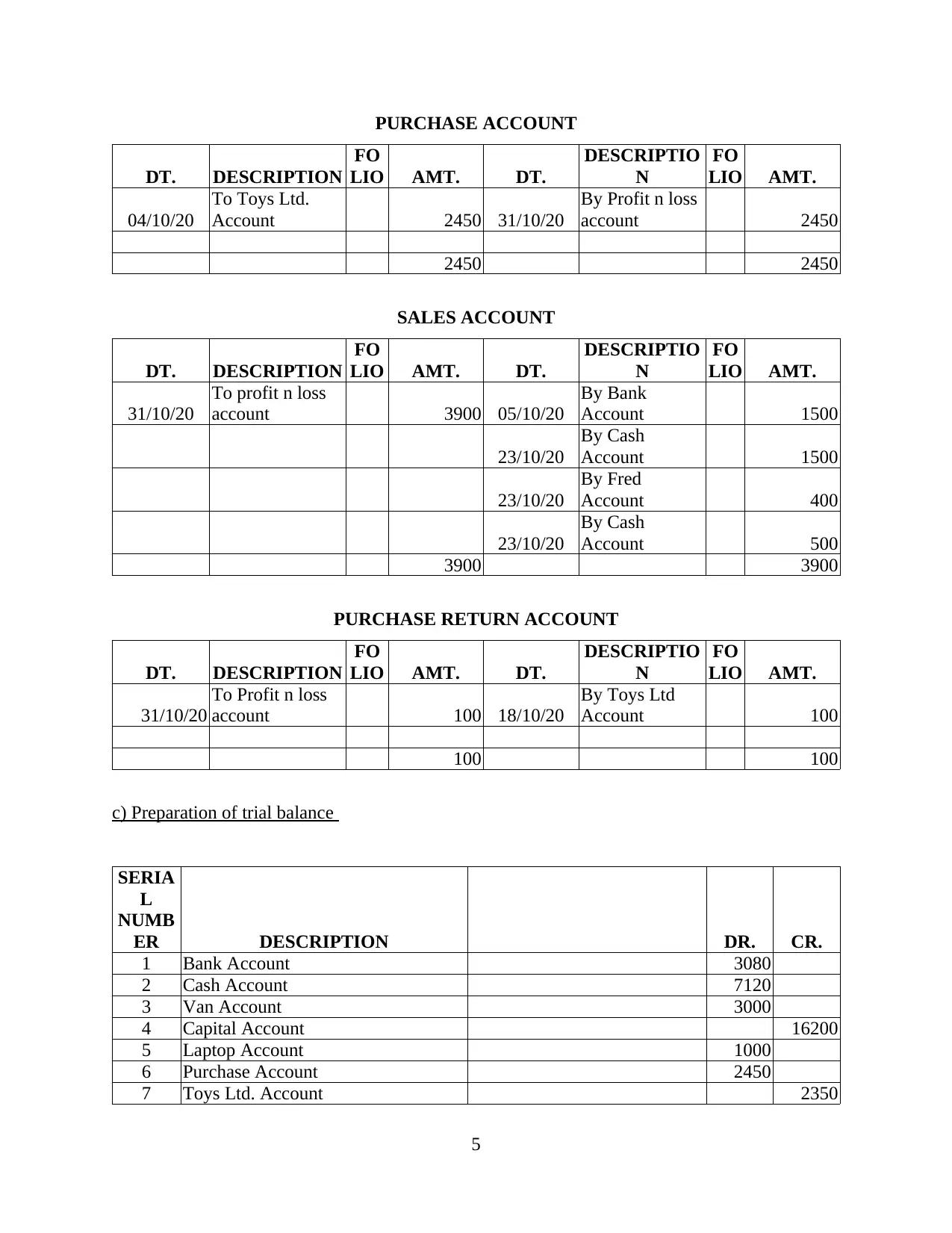
PURCHASE ACCOUNT
DT. DESCRIPTION
FO
LIO AMT. DT.
DESCRIPTIO
N
FO
LIO AMT.
04/10/20
To Toys Ltd.
Account 2450 31/10/20
By Profit n loss
account 2450
2450 2450
SALES ACCOUNT
DT. DESCRIPTION
FO
LIO AMT. DT.
DESCRIPTIO
N
FO
LIO AMT.
31/10/20
To profit n loss
account 3900 05/10/20
By Bank
Account 1500
23/10/20
By Cash
Account 1500
23/10/20
By Fred
Account 400
23/10/20
By Cash
Account 500
3900 3900
PURCHASE RETURN ACCOUNT
DT. DESCRIPTION
FO
LIO AMT. DT.
DESCRIPTIO
N
FO
LIO AMT.
31/10/20
To Profit n loss
account 100 18/10/20
By Toys Ltd
Account 100
100 100
c) Preparation of trial balance
SERIA
L
NUMB
ER DESCRIPTION DR. CR.
1 Bank Account 3080
2 Cash Account 7120
3 Van Account 3000
4 Capital Account 16200
5 Laptop Account 1000
6 Purchase Account 2450
7 Toys Ltd. Account 2350
5
DT. DESCRIPTION
FO
LIO AMT. DT.
DESCRIPTIO
N
FO
LIO AMT.
04/10/20
To Toys Ltd.
Account 2450 31/10/20
By Profit n loss
account 2450
2450 2450
SALES ACCOUNT
DT. DESCRIPTION
FO
LIO AMT. DT.
DESCRIPTIO
N
FO
LIO AMT.
31/10/20
To profit n loss
account 3900 05/10/20
By Bank
Account 1500
23/10/20
By Cash
Account 1500
23/10/20
By Fred
Account 400
23/10/20
By Cash
Account 500
3900 3900
PURCHASE RETURN ACCOUNT
DT. DESCRIPTION
FO
LIO AMT. DT.
DESCRIPTIO
N
FO
LIO AMT.
31/10/20
To Profit n loss
account 100 18/10/20
By Toys Ltd
Account 100
100 100
c) Preparation of trial balance
SERIA
L
NUMB
ER DESCRIPTION DR. CR.
1 Bank Account 3080
2 Cash Account 7120
3 Van Account 3000
4 Capital Account 16200
5 Laptop Account 1000
6 Purchase Account 2450
7 Toys Ltd. Account 2350
5
Paraphrase This Document
Need a fresh take? Get an instant paraphrase of this document with our AI Paraphraser
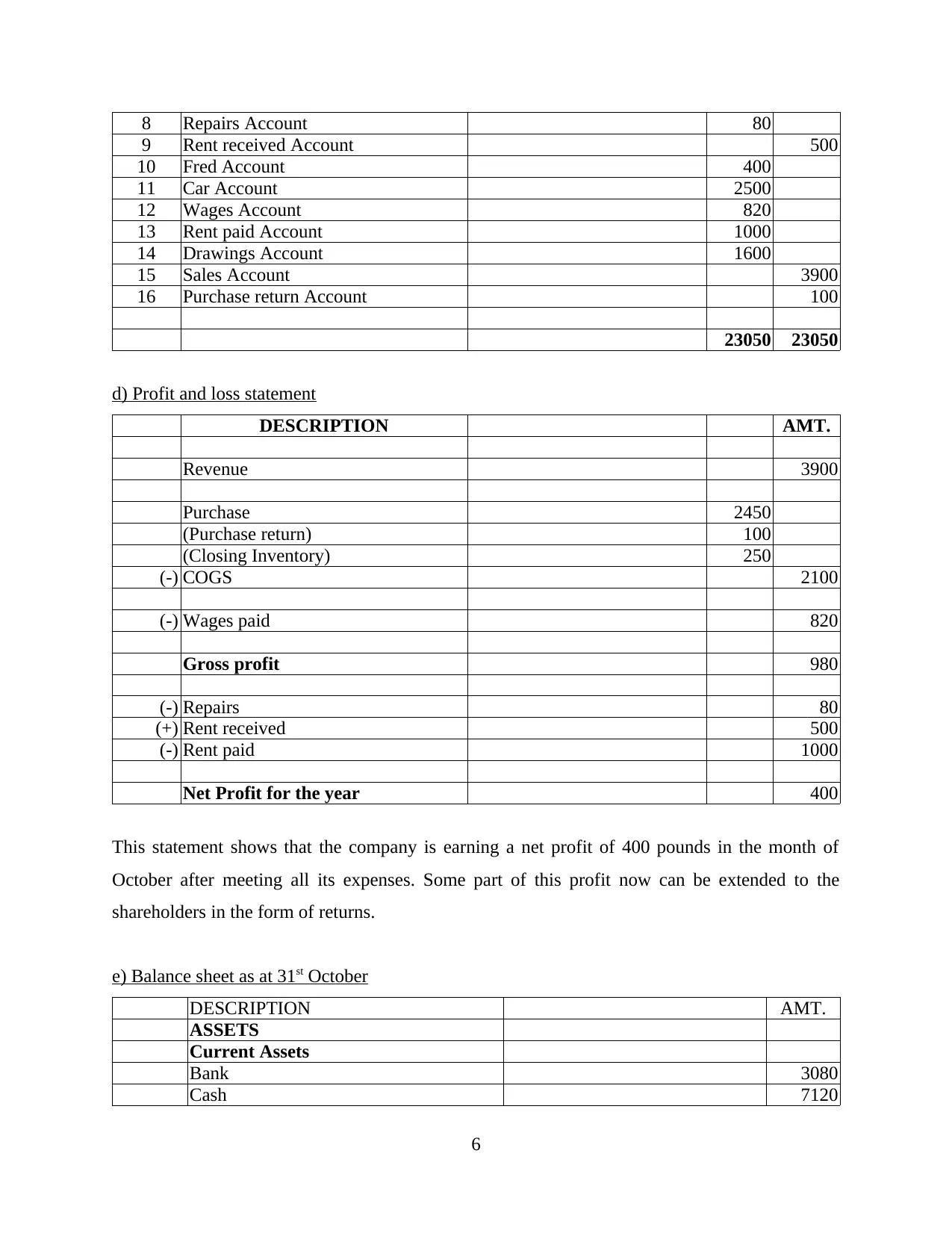
8 Repairs Account 80
9 Rent received Account 500
10 Fred Account 400
11 Car Account 2500
12 Wages Account 820
13 Rent paid Account 1000
14 Drawings Account 1600
15 Sales Account 3900
16 Purchase return Account 100
23050 23050
d) Profit and loss statement
DESCRIPTION AMT.
Revenue 3900
Purchase 2450
(Purchase return) 100
(Closing Inventory) 250
(-) COGS 2100
(-) Wages paid 820
Gross profit 980
(-) Repairs 80
(+) Rent received 500
(-) Rent paid 1000
Net Profit for the year 400
This statement shows that the company is earning a net profit of 400 pounds in the month of
October after meeting all its expenses. Some part of this profit now can be extended to the
shareholders in the form of returns.
e) Balance sheet as at 31st October
DESCRIPTION AMT.
ASSETS
Current Assets
Bank 3080
Cash 7120
6
9 Rent received Account 500
10 Fred Account 400
11 Car Account 2500
12 Wages Account 820
13 Rent paid Account 1000
14 Drawings Account 1600
15 Sales Account 3900
16 Purchase return Account 100
23050 23050
d) Profit and loss statement
DESCRIPTION AMT.
Revenue 3900
Purchase 2450
(Purchase return) 100
(Closing Inventory) 250
(-) COGS 2100
(-) Wages paid 820
Gross profit 980
(-) Repairs 80
(+) Rent received 500
(-) Rent paid 1000
Net Profit for the year 400
This statement shows that the company is earning a net profit of 400 pounds in the month of
October after meeting all its expenses. Some part of this profit now can be extended to the
shareholders in the form of returns.
e) Balance sheet as at 31st October
DESCRIPTION AMT.
ASSETS
Current Assets
Bank 3080
Cash 7120
6
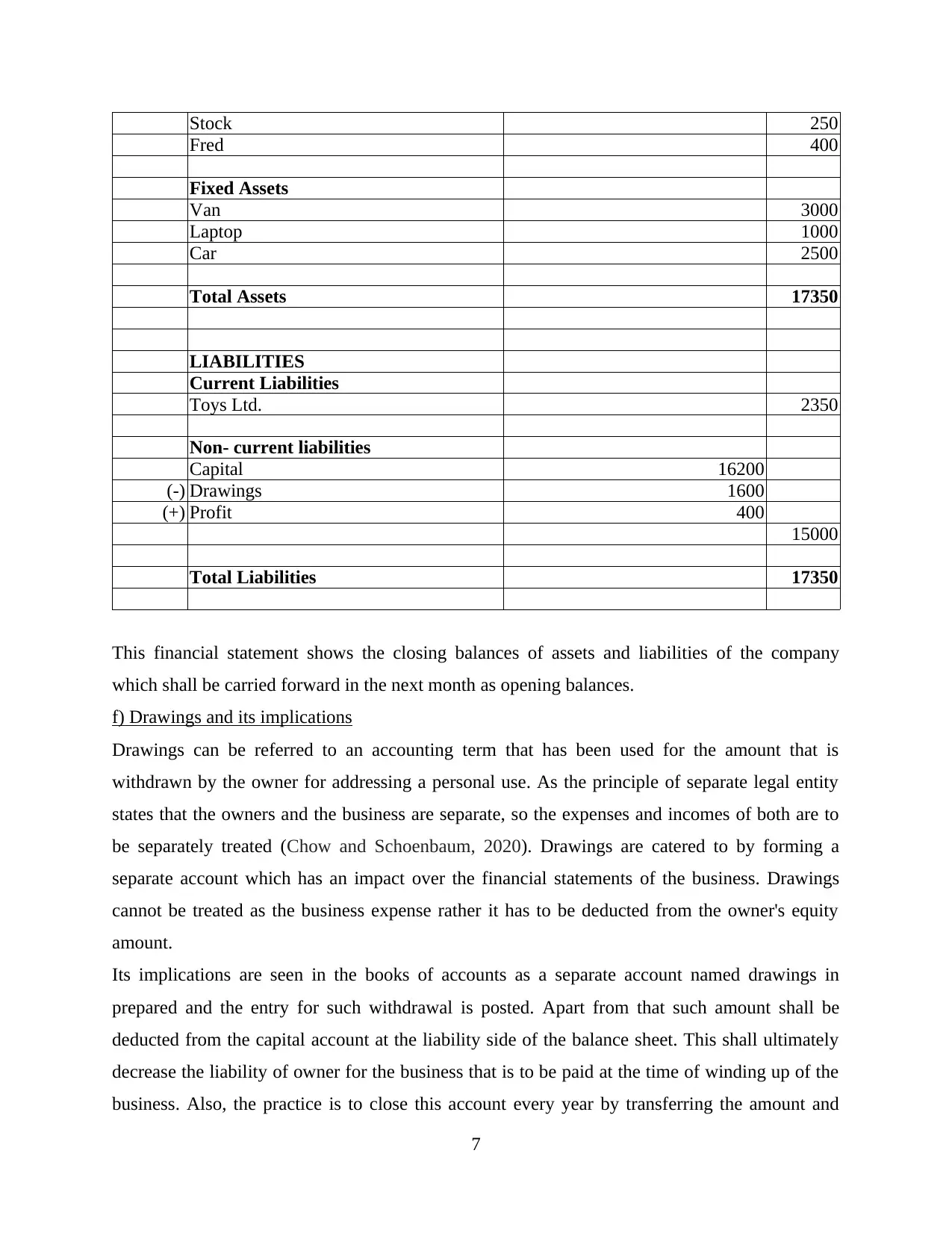
Stock 250
Fred 400
Fixed Assets
Van 3000
Laptop 1000
Car 2500
Total Assets 17350
LIABILITIES
Current Liabilities
Toys Ltd. 2350
Non- current liabilities
Capital 16200
(-) Drawings 1600
(+) Profit 400
15000
Total Liabilities 17350
This financial statement shows the closing balances of assets and liabilities of the company
which shall be carried forward in the next month as opening balances.
f) Drawings and its implications
Drawings can be referred to an accounting term that has been used for the amount that is
withdrawn by the owner for addressing a personal use. As the principle of separate legal entity
states that the owners and the business are separate, so the expenses and incomes of both are to
be separately treated (Chow and Schoenbaum, 2020). Drawings are catered to by forming a
separate account which has an impact over the financial statements of the business. Drawings
cannot be treated as the business expense rather it has to be deducted from the owner's equity
amount.
Its implications are seen in the books of accounts as a separate account named drawings in
prepared and the entry for such withdrawal is posted. Apart from that such amount shall be
deducted from the capital account at the liability side of the balance sheet. This shall ultimately
decrease the liability of owner for the business that is to be paid at the time of winding up of the
business. Also, the practice is to close this account every year by transferring the amount and
7
Fred 400
Fixed Assets
Van 3000
Laptop 1000
Car 2500
Total Assets 17350
LIABILITIES
Current Liabilities
Toys Ltd. 2350
Non- current liabilities
Capital 16200
(-) Drawings 1600
(+) Profit 400
15000
Total Liabilities 17350
This financial statement shows the closing balances of assets and liabilities of the company
which shall be carried forward in the next month as opening balances.
f) Drawings and its implications
Drawings can be referred to an accounting term that has been used for the amount that is
withdrawn by the owner for addressing a personal use. As the principle of separate legal entity
states that the owners and the business are separate, so the expenses and incomes of both are to
be separately treated (Chow and Schoenbaum, 2020). Drawings are catered to by forming a
separate account which has an impact over the financial statements of the business. Drawings
cannot be treated as the business expense rather it has to be deducted from the owner's equity
amount.
Its implications are seen in the books of accounts as a separate account named drawings in
prepared and the entry for such withdrawal is posted. Apart from that such amount shall be
deducted from the capital account at the liability side of the balance sheet. This shall ultimately
decrease the liability of owner for the business that is to be paid at the time of winding up of the
business. Also, the practice is to close this account every year by transferring the amount and
7
⊘ This is a preview!⊘
Do you want full access?
Subscribe today to unlock all pages.

Trusted by 1+ million students worldwide
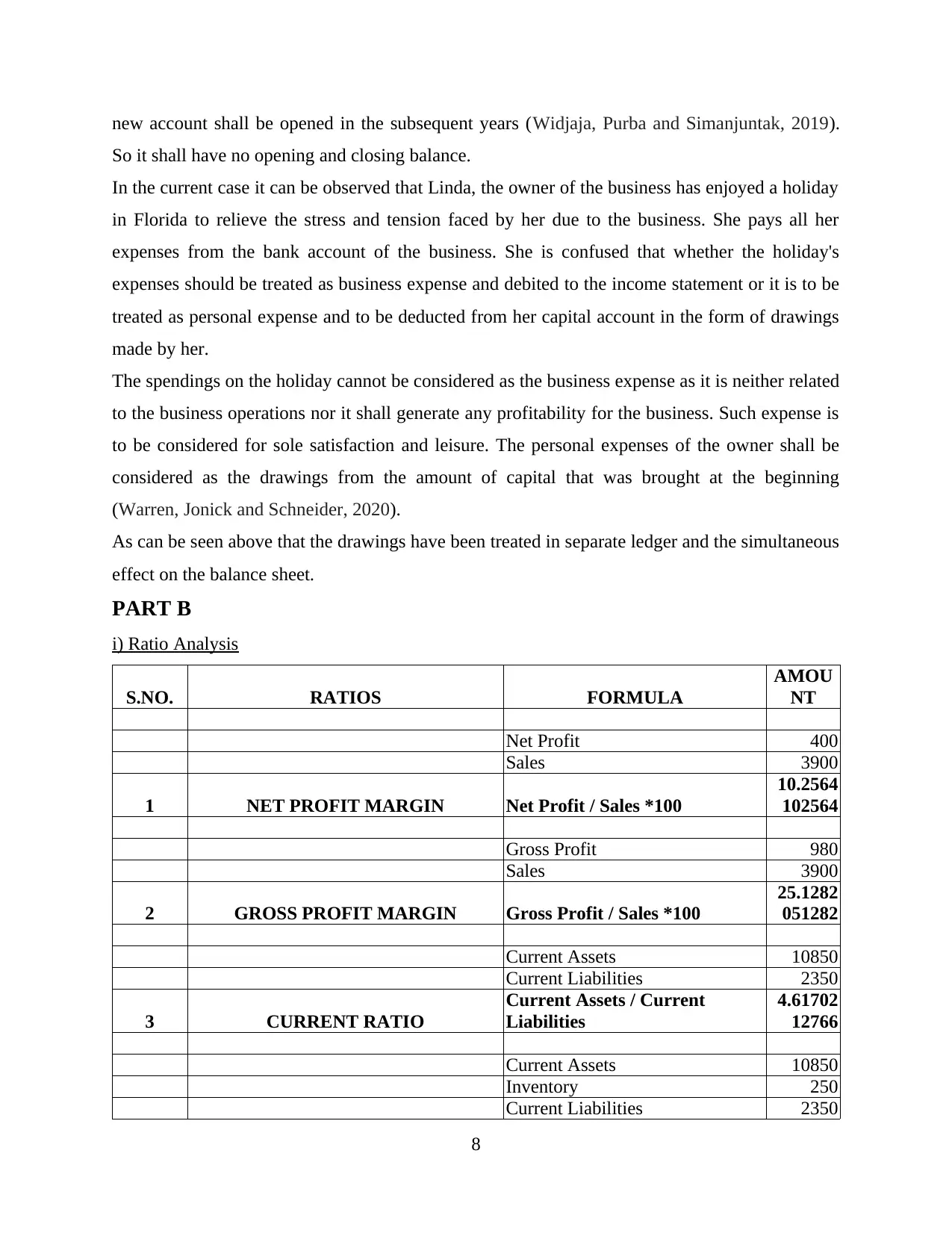
new account shall be opened in the subsequent years (Widjaja, Purba and Simanjuntak, 2019).
So it shall have no opening and closing balance.
In the current case it can be observed that Linda, the owner of the business has enjoyed a holiday
in Florida to relieve the stress and tension faced by her due to the business. She pays all her
expenses from the bank account of the business. She is confused that whether the holiday's
expenses should be treated as business expense and debited to the income statement or it is to be
treated as personal expense and to be deducted from her capital account in the form of drawings
made by her.
The spendings on the holiday cannot be considered as the business expense as it is neither related
to the business operations nor it shall generate any profitability for the business. Such expense is
to be considered for sole satisfaction and leisure. The personal expenses of the owner shall be
considered as the drawings from the amount of capital that was brought at the beginning
(Warren, Jonick and Schneider, 2020).
As can be seen above that the drawings have been treated in separate ledger and the simultaneous
effect on the balance sheet.
PART B
i) Ratio Analysis
S.NO. RATIOS FORMULA
AMOU
NT
Net Profit 400
Sales 3900
1 NET PROFIT MARGIN Net Profit / Sales *100
10.2564
102564
Gross Profit 980
Sales 3900
2 GROSS PROFIT MARGIN Gross Profit / Sales *100
25.1282
051282
Current Assets 10850
Current Liabilities 2350
3 CURRENT RATIO
Current Assets / Current
Liabilities
4.61702
12766
Current Assets 10850
Inventory 250
Current Liabilities 2350
8
So it shall have no opening and closing balance.
In the current case it can be observed that Linda, the owner of the business has enjoyed a holiday
in Florida to relieve the stress and tension faced by her due to the business. She pays all her
expenses from the bank account of the business. She is confused that whether the holiday's
expenses should be treated as business expense and debited to the income statement or it is to be
treated as personal expense and to be deducted from her capital account in the form of drawings
made by her.
The spendings on the holiday cannot be considered as the business expense as it is neither related
to the business operations nor it shall generate any profitability for the business. Such expense is
to be considered for sole satisfaction and leisure. The personal expenses of the owner shall be
considered as the drawings from the amount of capital that was brought at the beginning
(Warren, Jonick and Schneider, 2020).
As can be seen above that the drawings have been treated in separate ledger and the simultaneous
effect on the balance sheet.
PART B
i) Ratio Analysis
S.NO. RATIOS FORMULA
AMOU
NT
Net Profit 400
Sales 3900
1 NET PROFIT MARGIN Net Profit / Sales *100
10.2564
102564
Gross Profit 980
Sales 3900
2 GROSS PROFIT MARGIN Gross Profit / Sales *100
25.1282
051282
Current Assets 10850
Current Liabilities 2350
3 CURRENT RATIO
Current Assets / Current
Liabilities
4.61702
12766
Current Assets 10850
Inventory 250
Current Liabilities 2350
8
Paraphrase This Document
Need a fresh take? Get an instant paraphrase of this document with our AI Paraphraser
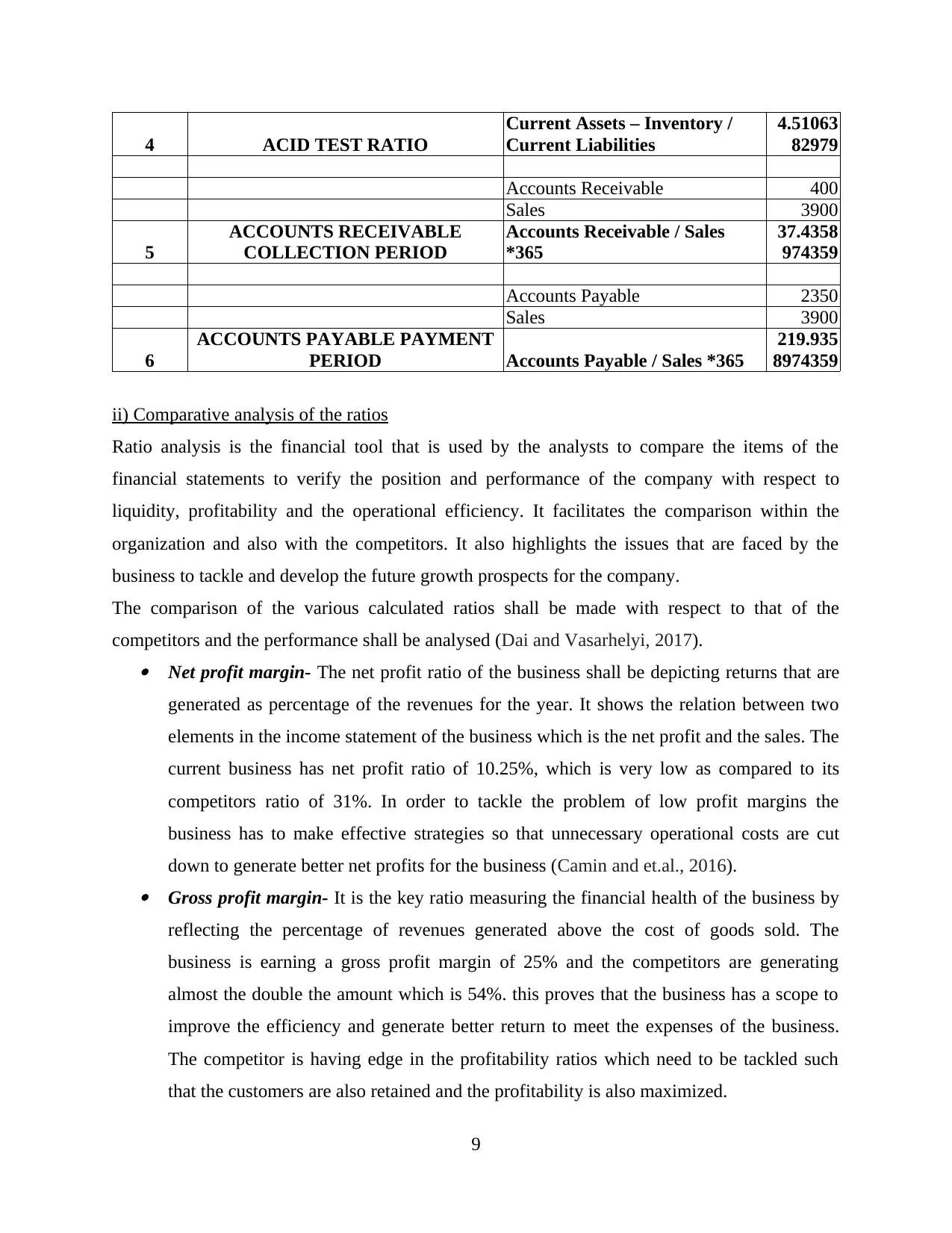
4 ACID TEST RATIO
Current Assets – Inventory /
Current Liabilities
4.51063
82979
Accounts Receivable 400
Sales 3900
5
ACCOUNTS RECEIVABLE
COLLECTION PERIOD
Accounts Receivable / Sales
*365
37.4358
974359
Accounts Payable 2350
Sales 3900
6
ACCOUNTS PAYABLE PAYMENT
PERIOD Accounts Payable / Sales *365
219.935
8974359
ii) Comparative analysis of the ratios
Ratio analysis is the financial tool that is used by the analysts to compare the items of the
financial statements to verify the position and performance of the company with respect to
liquidity, profitability and the operational efficiency. It facilitates the comparison within the
organization and also with the competitors. It also highlights the issues that are faced by the
business to tackle and develop the future growth prospects for the company.
The comparison of the various calculated ratios shall be made with respect to that of the
competitors and the performance shall be analysed (Dai and Vasarhelyi, 2017). Net profit margin- The net profit ratio of the business shall be depicting returns that are
generated as percentage of the revenues for the year. It shows the relation between two
elements in the income statement of the business which is the net profit and the sales. The
current business has net profit ratio of 10.25%, which is very low as compared to its
competitors ratio of 31%. In order to tackle the problem of low profit margins the
business has to make effective strategies so that unnecessary operational costs are cut
down to generate better net profits for the business (Camin and et.al., 2016). Gross profit margin- It is the key ratio measuring the financial health of the business by
reflecting the percentage of revenues generated above the cost of goods sold. The
business is earning a gross profit margin of 25% and the competitors are generating
almost the double the amount which is 54%. this proves that the business has a scope to
improve the efficiency and generate better return to meet the expenses of the business.
The competitor is having edge in the profitability ratios which need to be tackled such
that the customers are also retained and the profitability is also maximized.
9
Current Assets – Inventory /
Current Liabilities
4.51063
82979
Accounts Receivable 400
Sales 3900
5
ACCOUNTS RECEIVABLE
COLLECTION PERIOD
Accounts Receivable / Sales
*365
37.4358
974359
Accounts Payable 2350
Sales 3900
6
ACCOUNTS PAYABLE PAYMENT
PERIOD Accounts Payable / Sales *365
219.935
8974359
ii) Comparative analysis of the ratios
Ratio analysis is the financial tool that is used by the analysts to compare the items of the
financial statements to verify the position and performance of the company with respect to
liquidity, profitability and the operational efficiency. It facilitates the comparison within the
organization and also with the competitors. It also highlights the issues that are faced by the
business to tackle and develop the future growth prospects for the company.
The comparison of the various calculated ratios shall be made with respect to that of the
competitors and the performance shall be analysed (Dai and Vasarhelyi, 2017). Net profit margin- The net profit ratio of the business shall be depicting returns that are
generated as percentage of the revenues for the year. It shows the relation between two
elements in the income statement of the business which is the net profit and the sales. The
current business has net profit ratio of 10.25%, which is very low as compared to its
competitors ratio of 31%. In order to tackle the problem of low profit margins the
business has to make effective strategies so that unnecessary operational costs are cut
down to generate better net profits for the business (Camin and et.al., 2016). Gross profit margin- It is the key ratio measuring the financial health of the business by
reflecting the percentage of revenues generated above the cost of goods sold. The
business is earning a gross profit margin of 25% and the competitors are generating
almost the double the amount which is 54%. this proves that the business has a scope to
improve the efficiency and generate better return to meet the expenses of the business.
The competitor is having edge in the profitability ratios which need to be tackled such
that the customers are also retained and the profitability is also maximized.
9
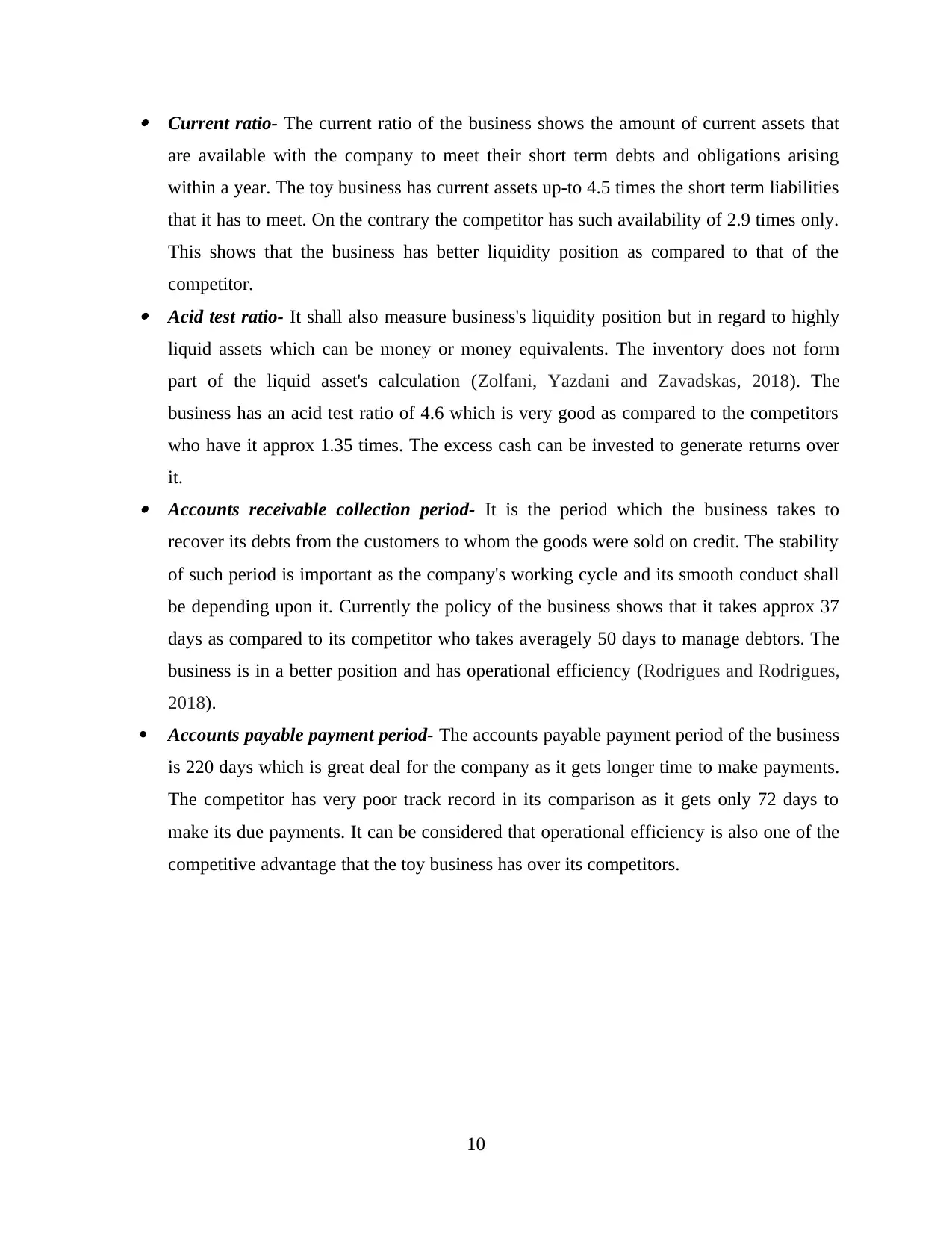
Current ratio- The current ratio of the business shows the amount of current assets that
are available with the company to meet their short term debts and obligations arising
within a year. The toy business has current assets up-to 4.5 times the short term liabilities
that it has to meet. On the contrary the competitor has such availability of 2.9 times only.
This shows that the business has better liquidity position as compared to that of the
competitor. Acid test ratio- It shall also measure business's liquidity position but in regard to highly
liquid assets which can be money or money equivalents. The inventory does not form
part of the liquid asset's calculation (Zolfani, Yazdani and Zavadskas, 2018). The
business has an acid test ratio of 4.6 which is very good as compared to the competitors
who have it approx 1.35 times. The excess cash can be invested to generate returns over
it. Accounts receivable collection period- It is the period which the business takes to
recover its debts from the customers to whom the goods were sold on credit. The stability
of such period is important as the company's working cycle and its smooth conduct shall
be depending upon it. Currently the policy of the business shows that it takes approx 37
days as compared to its competitor who takes averagely 50 days to manage debtors. The
business is in a better position and has operational efficiency (Rodrigues and Rodrigues,
2018).
Accounts payable payment period- The accounts payable payment period of the business
is 220 days which is great deal for the company as it gets longer time to make payments.
The competitor has very poor track record in its comparison as it gets only 72 days to
make its due payments. It can be considered that operational efficiency is also one of the
competitive advantage that the toy business has over its competitors.
10
are available with the company to meet their short term debts and obligations arising
within a year. The toy business has current assets up-to 4.5 times the short term liabilities
that it has to meet. On the contrary the competitor has such availability of 2.9 times only.
This shows that the business has better liquidity position as compared to that of the
competitor. Acid test ratio- It shall also measure business's liquidity position but in regard to highly
liquid assets which can be money or money equivalents. The inventory does not form
part of the liquid asset's calculation (Zolfani, Yazdani and Zavadskas, 2018). The
business has an acid test ratio of 4.6 which is very good as compared to the competitors
who have it approx 1.35 times. The excess cash can be invested to generate returns over
it. Accounts receivable collection period- It is the period which the business takes to
recover its debts from the customers to whom the goods were sold on credit. The stability
of such period is important as the company's working cycle and its smooth conduct shall
be depending upon it. Currently the policy of the business shows that it takes approx 37
days as compared to its competitor who takes averagely 50 days to manage debtors. The
business is in a better position and has operational efficiency (Rodrigues and Rodrigues,
2018).
Accounts payable payment period- The accounts payable payment period of the business
is 220 days which is great deal for the company as it gets longer time to make payments.
The competitor has very poor track record in its comparison as it gets only 72 days to
make its due payments. It can be considered that operational efficiency is also one of the
competitive advantage that the toy business has over its competitors.
10
⊘ This is a preview!⊘
Do you want full access?
Subscribe today to unlock all pages.

Trusted by 1+ million students worldwide
1 out of 13
Related Documents
Your All-in-One AI-Powered Toolkit for Academic Success.
+13062052269
info@desklib.com
Available 24*7 on WhatsApp / Email
![[object Object]](/_next/static/media/star-bottom.7253800d.svg)
Unlock your academic potential
Copyright © 2020–2025 A2Z Services. All Rights Reserved. Developed and managed by ZUCOL.





